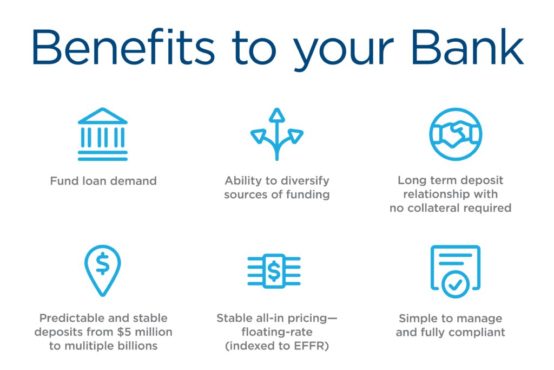If you’re a bank treasurer or liquidity manager focused on deposits, sweep programs are likely on your radar screen or already part of your funding mix. Approximately 40% of all U.S. banks use brokered deposits as a funding source, according to the latest figures from the FDIC.
What is an FDIC insured sweep program?
An insured deposit program, also known as an FDIC sweep program, is a liquid alternative overnight investment. This program leverages expanded FDIC insurance coverage, which is a feature other accounts, like money market funds, cannot provide.
With this program, customers can earn interest on idle cash balances and manage risk with FDIC insurance while providing banks an attractive, more diversified source of funding and liquidity.
How an FDIC insured sweep deposit program works
Insured sweep deposits are a subset of the larger category of brokered deposits. Sweep funding comes from uninvested cash balances held in customer accounts at source companies, such as broker-dealers, registered investment advisors, financial technology firms and corporate trusts. These funds are often highly cost-effective for banks, in part because banks are not required to pledge any collateral. Other benefits include bringing additional diversification and stability to the deposit base.
Put these potential benefits together, and it’s not surprising that FDIC insured sweep deposit programs continue to experience year-over-year growth. Since banks are currently not required to break out sweep deposits on their call reports, it is hard to put an exact number on the overall size of the FDIC insured sweep deposit marketplace. However, overall brokered deposits have grown from $655 billion in 2009 to $1.1 trillion at the end of 2019, clearly suggestive, in our view, of the growth in the FDIC insured sweep portion as well.

Evaluating bank hesitation to accept brokered sweep deposits
So, what about the 60% of U.S. banks that aren’t currently taking brokered sweep deposits? In some cases, bank leadership may simply not see a need to diversify its deposit mix. But in other cases, there may be hesitation due to a misunderstanding of the actual day-to-day management of an FDIC insured sweep program.
Since UMB started our proprietary FDIC Sweep program in 2007, Operational simplicity has been extremely important to the bank treasurers and liquidity managers we work with. Bank leadership may hesitate to participate in an insured deposit program if they perceive it as a hassle — either during initial setup or just the day-to-day management of these deposits.
A simplified approach to insured sweep deposit programs
FDIC insured sweep deposit programs are administered in a variety of ways across the industry. At UMB, we utilize a dual account structure with each participating bank opening two omnibus accounts: a money market deposit account (MMDA) and a demand deposit account (DDA). UMB actively manages all the operations and provides daily and month-end reporting through our proprietary platform and dedicated sweep operations team. There will either be a daily incoming wire to your bank or a daily wire out. At month end, your bank will be instructed as to the amount of interest to credit to the DDA.
We built the program this way because, as a bank, we see things through the lens of a bank. Given the clear benefits, we expect the percentage of banks utilizing insured sweep deposits will continue to rise. Again, many bank executives are already familiar with these benefits – even to those who are not participating at present. If you are in that group, I encourage you to consider operational simplicity and the importance of building true long-term deposit relationships as you evaluate how best to meet your funding needs.
Click here to learn more about UMB’s investor solutions services and offerings.





